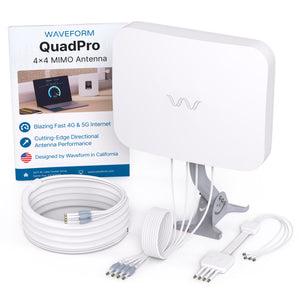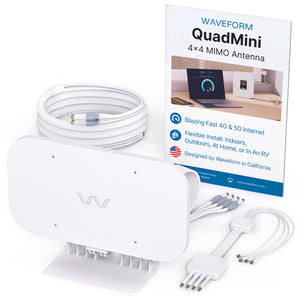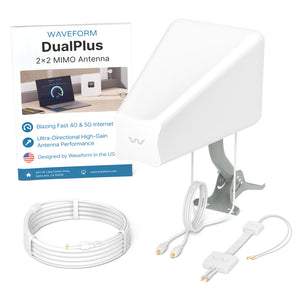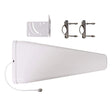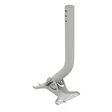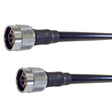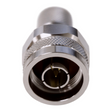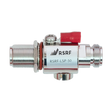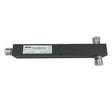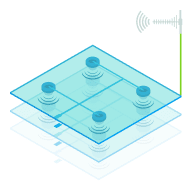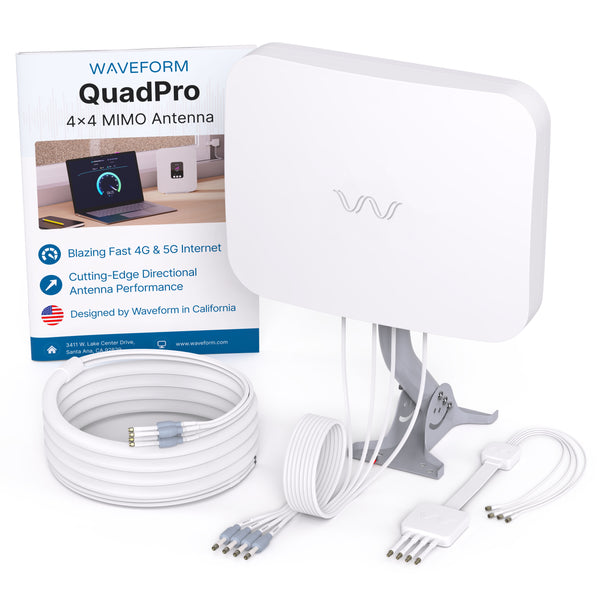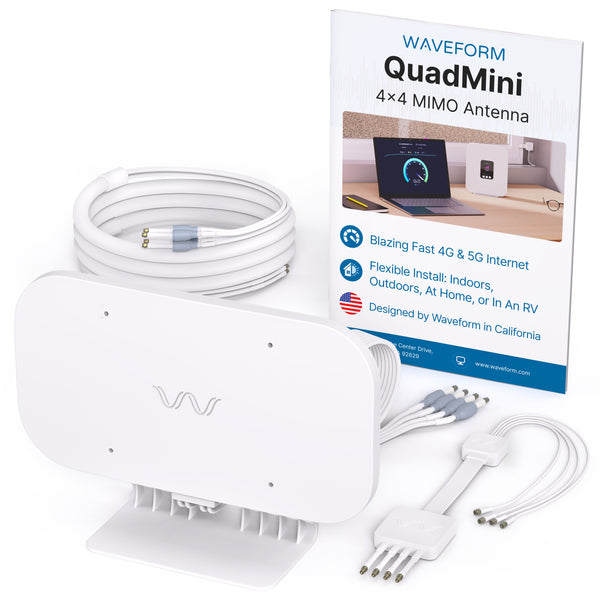We're going to break down all the need-to-know info about MIMO antennas: what they are, how they work, and why they matter.
This guide is a general introduction to MIMO technology. If you’re looking for our Waveform MIMO antennas to supercharge your cellular Internet connectivity, just click through to our guides for different hotspots and modems, and our full line-up of antennas.
Or simply read about our two most popular 5G MIMO antennas:
- Ultra-performance, highly-directional external antenna.
- Simple and versatile installation using FlexMount.
- Compatible with 4G & 5G on AT&T, Verizon, and T-Mobile.
- Unmatched home and business 5G Internet.
- No aiming required
- Multiple mounting options: Includes desktop mount, suction cups, pole mount, or screw holes.
- At home or on the road: Designed for fixed installations and for use in RVs and motor-homes.
Okay, let’s get stuck in!
MIMO (multiple-input and multiple-output) antennas are a technology that improve the performance of wireless communication systems.
MIMO uses multiple antennas to handle multiple signal paths simultaneously. With multiple transmitters and receivers (often referred to as 'elements'), MIMO enables devices to send and receive data faster than a single antenna can.
Here’s a simple analogy: think of a MIMO antenna as a team of workers.
Instead of having one worker (or antenna element) take on all the tasks (or data transmission), a MIMO antenna employs multiple workers (elements) to divide and conquer the tasks. This team approach results in a much more efficient process, enabling faster data transmission and improved signal quality.
MIMO is a key component of modern wireless technologies such as 4G LTE, 5G NR, WiFi 5, 6, and 6E.
MIMO vs. Single Antenna: What's the Difference and Which to Choose?
Once you start exploring antenna options, you'll likely come across both MIMO antennas and single, or SISO (Single Input, Single Output), antennas.
So, what's the difference, and how do you know which one you need? Let's break it down.
The Difference
As we've mentioned earlier, MIMO antennas use multiple elements to send and receive data at the same time. This capability allows for increased data rates and better signal quality, especially in environments where there might be interference or weak signal strength.
On the other hand, a SISO antenna has just one transmitter and one receiver. It can only send or receive data one at a time, which can limit the speed and reliability of your wireless connection, especially in situations where there's a lot of data being transmitted.
How much faster is MIMO than SISO?
The exact number varies depending on the signal but, going from SISO to 2x2 MIMO adds about a 30% increase in connection speeds. You get a similar bump going from 2x2 to 4x4, so a 4x4 antenna can get you 70% faster data rates than a SISO antenna.
This benefit exists even if the cell tower (or wifi router) is congested. A MIMO antenna allows more data to be sent over the same spectrum resources.
How should I decide between getting a SISO, 2x2, or 4x4 MIMO antenna?
The choice between SISO, 2x2, and 4x4 MIMO antennas really depends on your device.
If you have a device that supports 4x4 MIMO, it’s best to use a 4x4 antenna. Same with 2x2 or SISO.
Why not use a 2x2 antenna with a 4x4 device?
We don’t recommend doing this because when using a 2x2 antenna with a 4x4 device, you need to decide which two ports to connect to the antenna. And critically: not all ports broadcast all the same frequencies.
For example, even the latest 5G devices will only use 2x1 or 2x2 on low frequency cellular bands (like 600 MHz n71 or 700 MHz band 12/13). But the same device will use 4x4 on mid-bands (like 2500 MHz n41 or 3500 MHz n78). So different frequencies will come on different ports, so if you use a SISO antenna or a 2x2 antenna with a 4x4 device, some bands may not broadcast at all! You need to match the antenna to the device you have.
If you've got two antenna ports, then you need something like our 2x2 MIMO Antenna Kit, while if you're working with four external antenna ports, it's usually best to go with a 4x4 MIMO Antenna kit.
2x2 and 4x4 MIMO
2x2 and 4x4 MIMO: What's the Difference?
If you’ve decided you need a MIMO, not a single antenna, you'll come across terms like 2x2, 4x4, and 8x8 MIMO. These numbers refer to the number of transmitters (the first number) and receivers (the second number) in a MIMO system.
2x2 MIMO
In a 2x2 MIMO system, there are two transmitters and two receivers.
In most cases the two antennas will be “cross-polarized” - this is a way of arranging the antennas on top of each other in an “x” or a “+” shape such that they’re isolated from each other.
This setup can send and receive two data streams concurrently. 2x2 MIMO is commonly found in many consumer-grade WiFi routers and some 4G and 5G devices. There is typically a 30% increase in data rates over SISO (Single Input, Single Output) systems, but 2x2 doesn't offer the same degree of performance as higher-order MIMO systems.
4x4 MIMO
A 4x4 MIMO system steps things up with four transmitters and four receivers. This allows for up to four “spatially multiplexed” data streams, and a further 30% increase in data speed over 2x2 MIMO. 4x4 MIMO is often found in higher-end WiFi routers and some advanced 4G and 5G devices.
In reality, a 4x4 MIMO antenna typically consists of two 2x2 cross-polarized antennas. The antennas are simply spaced within the device.
Which Should I Choose?
The best option is to match your MIMO antenna to the device you purchase. For example, there's no point in getting a 4x4 MIMO antenna if your device only supports 2x2 MIMO. Also, since not all antenna ports transmit the same frequencies (see our section above about MIMO vs. SISO), using a 2x2 MIMO antenna with a 4x4 MIMO device may mean that some frequencies don’t get transmitted at all.
MIMO Antenna Types: Log-Periodic vs. Panel vs. Dish
Selecting a MIMO antenna isn’t just about deciding the number of elements (2x2, 4x4) you need. In this section, we'll simplify three common types of MIMO antennas: Log-Periodic, Panel, and Dish antennas, and help you understand which might be the best fit for your needs.
Panel Antennas
Panel antennas are flat, rectangular antennas that are typically used indoors or mounted on walls or structures outdoors. They provide a somewhat directional signal that can be used to focus coverage in a specific area or direction.
Since panel antennas typically aren’t highly directional, they are relatively easy to aim and do a good job of capturing reflected signals which can improve performance when there are obstacles between you and the cell tower.
Log-Periodic Antennas
Log-Periodic antennas, also known as LPDA (Log-Periodic Dipole Array) antennas, are directional antennas that can cover a wide range of frequencies. They are characterized by a series of elements of varying lengths arranged along a support boom, giving them a unique "fishbone" appearance. Often the antenna itself is housed in a white PVC box that looks triangular.
The strength of LPDA antennas lies in their broad frequency coverage and high gain. They're often used in outdoor settings when there is line of sight to the transmitter (often a cell tower or point to point wifi network).
Dish Antennas
Dish antennas are highly directional antennas that are often used in long-range wireless communication. They are characterized by their parabolic shape, which helps to focus the signal into a narrow beam.
Dish antennas can provide very high gain, making them ideal for situations where a strong, focused signal is required over long distances.
Omni Antennas
Omni antennas receive and send signals in a 360º radius. As they gather signals from all sides, they do not need to be pointed toward a cellular tower
They are best for boosting signal on many different carriers. They are suitable for situations where the existing signal strength is moderate to strong.
Mobile Antennas
Mobile antennas are omnidirectional MIMO antennas that boost signal in vehicles ranging from sedans to RVs, buses, and semi-trucks. They need to be high gain, while also robust and low-profile. It's also important to consider mounting options to attach the antenna to your vehicle easily and securely without causing any damage.
Other antennas
- Horn antennas have high directivity but medium gain. They’re great for having very few side lobes and thus rejecting interference.
- Sector antennas are essentially larger panel antennas with greater directivity and front-to-back isolation.
- Yagi antennas are similar to log periodic antennas but only cover small frequency ranges.
- Microstrip antennas are often embedded in devices such as smartphones, hotspots and routers and provide basic performance in a small space.
- Whip antennas are often used with wifi routers and some hotspots and gateways. They have an omni-directional pattern, but are limited in performance because they can’t easily be cross-polarized.
- Parabolic antennas are another high gain antenna, similar to a dish, but they are typically only SISO and not MIMO.
Which Should You Choose?
The choice between Log-Periodic, Panel, Omni, and Dish antennas will depend on your specific needs:
- Coverage: If you need to cover a large frequency range, a Log-Periodic antenna or an Omni antenna might be the best choice. For focused coverage in a specific area or direction, a Panel or Dish antenna could be more suitable.
- Range: For long-range communication, Dish antennas can provide the highest gain. However, for shorter ranges or when a wide coverage angle is needed, Log-Periodic or Panel antennas may be more appropriate.
MU-MIMO, SU-MIMO, and Massive MIMO
What is MU-MIMO, SU-MIMO, and Massive MIMO?
In the realm of wireless communications, MIMO (Multiple Input, Multiple Output) technology is a fundamental component that improves the performance of a network by leveraging multiple antennas at both the transmitter and receiver to create multiple paths for data transmission. This technology comes in several variants, including MU-MIMO, SU-MIMO, and Massive MIMO. Let's delve into what each of these terms means.
MU-MIMO: Multi-User MIMO
MU-MIMO, or Multi-User MIMO, is a technology that allows a MIMO antenna to communicate with multiple devices simultaneously. In a typical MIMO system, the antenna can only communicate with one device at a time. However, MU-MIMO technology splits the available bandwidth into separate streams that can be used to communicate with multiple devices concurrently.
This technology significantly improves network efficiency in environments where multiple devices are connected simultaneously, such as in a home or office setting. It's important to note that the devices also need to support MU-MIMO for this technology to work effectively.
SU-MIMO: Single User MIMO
SU-MIMO, or Single User MIMO, is the traditional form of MIMO, where the multiple data streams are all intended for a single device. This technology leverages the multiple antennas to either increase the data rate (through spatial multiplexing) or improve signal reliability (through diversity coding).
In spatial multiplexing, each antenna transmits a unique data stream, effectively multiplying the data rate. In contrast, with diversity coding, each antenna sends the same data to improve signal reliability. SU-MIMO is widely used in many WiFi and cellular systems.
Massive MIMO
Massive MIMO is a form of MIMO technology used in large-scale antenna systems, particularly in 5G networks. As the name suggests, Massive MIMO involves deploying a large number of antennas at the base station – potentially hundreds – to significantly improve signal quality and data rates.
The main advantage of Massive MIMO is its ability to focus the energy of the transmitted signal towards specific users through advanced beamforming. This results in a more efficient use of the frequency spectrum and enhances the capacity and performance of the network.
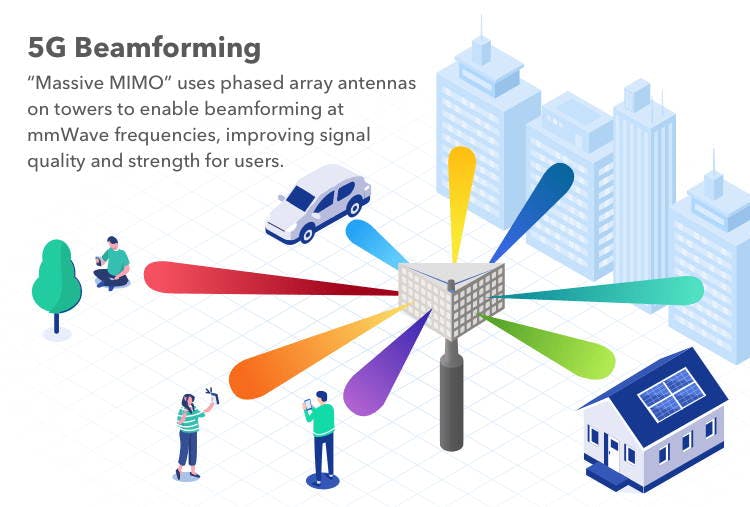
Key Takeaways
MU-MIMO, SU-MIMO, and Massive MIMO are all variants of MIMO technology, each with their own strengths and applications:
- MU-MIMO is used to improve network efficiency by communicating with multiple devices simultaneously, particularly useful in crowded environments.
- SU-MIMO enhances the data rate or signal reliability for single devices, widely used in many current wireless systems.
- Massive MIMO substantially boosts network capacity and performance in large-scale systems like 5G networks.
Does the gain of a MIMO antenna matter?
When discussing antennas, gain is a key concept that plays a significant role in the performance of the antenna system. This is also true in the context of MIMO (Multiple Input, Multiple Output) antennas. Let's delve into what gain is and why it matters for MIMO antennas.
Understanding Gain
In antenna terms, gain is a measure of an antenna's ability to direct input power into radiation in a specified direction. It's a measure of the antenna's effectiveness in converting input power into radio waves and broadcasting them in a desired direction. Gain is typically measured in decibels (dB).
A higher gain implies a more focused and further reaching signal. However, this doesn't mean the antenna is increasing the power of the signal; instead, it's focusing the existing power more efficiently.
Gain in MIMO Antennas
In a MIMO system, the antennas' gain can significantly impact the system's performance. A higher gain antenna can provide a stronger, more focused signal, which can lead to improved signal quality and increased data rates. This can be particularly beneficial in a MIMO system where multiple antennas are used to transmit and receive data simultaneously.
However, there's a trade-off to consider. While a high-gain antenna can provide a more focused signal, it also has a narrower beamwidth. This means it covers a smaller area, and it may also be more susceptible to alignment issues. On the other hand, a lower gain antenna might have a broader beamwidth and cover a larger area, but with a weaker signal.
Key Takeaways
The gain of a MIMO antenna does matter, and it's essential to consider the desired coverage area and the signal strength when choosing an antenna.
- Performance: Higher gain can improve the performance of the MIMO system by providing a stronger, more focused signal. This can lead to better signal quality and higher data rates.
- Coverage: The gain of the antenna will affect the coverage area. High-gain antennas have a more focused beam and a smaller coverage area, while low-gain antennas have a broader beam and a larger coverage area.
- Alignment: High-gain antennas are more sensitive to alignment. Proper alignment is crucial to ensure the signal is being directed where it's needed.
How do I install a MIMO antenna?
If you've chosen your antenna already, you can check out a detailed technical guide here. In the meantime, here's a simple, step-by-step rundown to give you an idea what's involved:
Step 1: Position and aim your antenna
This is the single most important part of a MIMO antenna set-up. Getting the right position will take time and trial and error, but it's worth it for the huge improvement in performance you'll get from a properly-aimed kit.
Step 2: Soft-install in test mode first
Assemble your MIMO antenna, hotspot/router, adapters, and cables, but don't hard-wire anything until you're confident you've got the optimum position.
Step 3: Position the Antennas
Here's where you need our in-depth guide. You need to find both the right location and the right direction to point your antenna!
Step 4: Get drilling
One you're confident your provisional set-up is the best for your environment, it's time to move to a permanent install.
Still stuck?
Don't worry, we've got you covered! Setting up and optimising antenna installations is what we love.
We can help you figure it out. Call us at (800) 761-3041 or email [email protected]. We’re available from 9am-5pm PT, Monday to Friday.
What is antenna polarization?
Imagine a radio wave moving through the air like a series of ripples moving through water. If these ripples move up and down, we call it vertical polarization. If they move side to side, that's horizontal polarization.
So, why does polarization matter? Well, for an antenna to pick up a signal really well, its polarization needs to match the incoming signal. If they're not the same, the signal might get weak and the data quality could drop.
That’s where MIMO antennas get really helpful: we can use different polarizations to transmit more information at the same time without causing a mix-up. For example, one signal can be sent using vertical polarization and another using horizontal polarization. Since these two are different, they won't interfere with each other and we can send and receive more data.
What about H+V vs +/- 45 polarization?
So horizontal and vertical polarization (H+V, also called cross polarization) can be imagined like ripples moving horizontally and vertically. +/- 45 degree polarization, also known as slant polarization, can be like ripples moving in diagonal lines. One set of ripples moves from the top left to the bottom right, and the other set from the top right to the bottom left. Just like with H+V, these two sets of ripples don't interfere with each other, letting you transmit and receive even more data at once. They can work really well in environments with high degrees of “multipath propagation” - where signals may bounce off obstacles and arrive at the receiver from various angles.
So which polarization do I want?
Basically in a MIMO antenna scenario you want to match what the cell tower is doing! For the most part that means if you’re doing cellular antennas, stick to +/- 45 degrees. At Waveform, that’s what all our antennas are. If you ever need to, you can easily just rotate the antenna by 45 degrees to go from +/- 45 to H+V.
What is the difference between polarized antenna pairs and spaced antenna pairs?
Polarized Antenna Pairs
So, first up, we've got polarized antenna pairs. This is like our H+V or +/- 45 degree polarization we talked about earlier. Imagine you're at a pond and you've got two pebbles. You toss one pebble so it creates ripples going up and down (vertical polarization), and the other so it creates ripples going side to side (horizontal polarization).
These "dancing" ripples don't mess with each other because they're moving in different directions. This way, you can send more data at one time without getting your signals mixed up. It's like having two super-efficient mail carriers delivering letters on two separate paths. They're both working at the same time, but they don't get in each other's way.
Spaced Antenna Pairs
Now, let's think about spaced antenna pairs. This is like standing at two different spots on the edge of a pond and tossing pebbles in at the same time. Both pebbles create similar ripples, spreading out in the same way. But since you're throwing them from different spots, the ripples don't overlap right away.
This setup gives you two separate points of signal reception, which can help you sort out any confusion if signals bounce around a lot before reaching their destination (called 'multipath propagation'). It's like having two cars driving to the same destination,, but they start from different points. If one car runs into a roadblock (like a tree fallen across the road), the other might still get through!
Spatial Multiplexing
Spatial multiplexing is like being able to toss multiple pebbles into the pond at once, from different spots along the edge. Each pebble creates its own set of ripples, spreading out from the point where the pebble hit the water. Because you're throwing the pebbles from different spots, the ripples spread out in different directions and don't mess with each other.
Each of these pebbles is like a different data stream. Since they're being sent from different points (or antennas), they don't interfere with each other, even though they're being sent at the same time. This is how spatial multiplexing lets you send a whole bunch of data at once, boosting the speed and efficiency of your wireless communication.
How does all this translate to actual antennas?
Our antennas use combinations of these technologies to achieve spatial multiplexing.
- 2x2 antennas are cross-polarized (using +/- 45 degree polarization)
- 4x4 antennas are 2x cross-polarized antennas which are spatially separated
- 8x8 antennas are 4x cross-polarized antennas which are spatially separated.
What's the difference between WiFi vs Cellular MIMO?
Wi-Fi MIMO
Wi-Fi MIMO (Multiple Input, Multiple Output) technology is widely used in home and business networks. It involves using multiple antennas at both the transmitter (such as your Wi-Fi router) and the receiver (like your laptop or smartphone) to improve communication performance.
Think of Wi-Fi MIMO like a multi-lane highway within a city. The city represents your home or office, and the cars on the highway are the data packets being sent and received.
Here's how it works:
Spatial Multiplexing: spatial multiplexing allows multiple data streams to be transmitted simultaneously via different paths. This is like having multiple lanes on our highway. Instead of all cars trying to use one lane, they can spread out and move simultaneously in separate lanes, increasing the overall flow and reducing traffic jams. This significantly increases the data rate without requiring additional bandwidth.
Beamforming: Some Wi-Fi MIMO systems use a technique called beamforming. Beamforming involves coordinating the antennas to send signals in a specific direction towards the receiver rather than broadcasting in all directions. This is like having smart traffic lights that can detect where the cars (data) want to go and optimize the green lights to get them there faster and more efficiently. Instead of signals being sent in all directions, they're directed exactly where they need to go. This can increase the signal strength and reduce interference.
Cellular MIMO
Cellular MIMO is used in mobile networks like 4G (LTE) and 5G. It shares the same basic principles with Wi-Fi MIMO, using multiple antennas to send and receive signals. Sticking with our cars and highways analogy, Cellular MIMO is like a vast network of highways that spans entire regions or countries. The cars are still our data packets, but now they're travelling much further. But there are some key differences between cellular and WiFI:
Scale: Cellular networks often operate on a larger scale than Wi-Fi, covering vast geographical areas. This requires advanced MIMO configurations. For instance, 4G typically uses 2x2 or 4x4 MIMO, while 5G can use up to 64x64 MIMO in some cases.
Massive MIMO: This is a technology used in 5G where a large number of antennas (dozens or even hundreds) are deployed at the base station to serve multiple user devices simultaneously. This is like adding even more lanes to our highway, and even introducing multi-level highways. With more lanes and levels (more antennas), you can handle much more traffic (data) at the same time. This significantly boosts capacity and coverage.
MU-MIMO: Both 4G and 5G networks use a tech called MU-MIMO (Multi-User MIMO). This allows a base station to communicate with multiple devices at the same time, sending different data to each one.
Key Differences
While Wi-Fi and Cellular MIMO both use multiple antennas to improve performance, the key differences lie in their scale, the specific techniques they use, and their typical use cases.
Wi-Fi MIMO is optimized for shorter-range communication, often inside a home or business, and its complexity is generally lower. On the other hand, Cellular MIMO is designed for long-range transmission over vast areas and can involve more complex configurations and techniques, such as Massive MIMO, especially in 5G networks.
In essence, Wi-Fi MIMO is like a city's local traffic system, designed to handle a smaller number of cars over shorter distances with fewer lanes. Cellular MIMO, on the other hand, is more like the national highway system, built to handle a much larger number of cars over greater distances, with many more lanes and sophisticated routing systems.
Again, we’ve got a great guide to 5G that explains even more detail about Massive MIMO and beamforming.
Deciding whether a MIMO antenna or a signal booster is better depends on your specific needs.
If you want the very best data rates, MIMO antennas are almost always the best choice. However, your device must have external antenna ports in order to be able to use a MIMO antenna.
If your devices don't have external antenna ports, or you need to cover multiple devices within a defined coverage area, a cell signal booster is a better choice.























